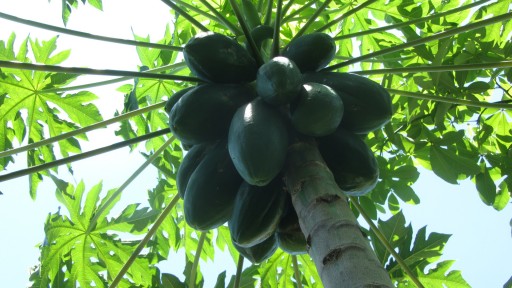The Magnificent Papaya
If you had to pick a tree that best represented the tropics, which one would it be? While there are a number of candidates for the likely symbol of the hot and humid regions, I would probably rate the papaya tree (Carica papaya) near the top. Its long branches stretching horizontally from the crown, the large green to yellow fruits hanging down graciously from the trunk, and the distinctive shape of their leaves give an unusual impression that will enthuse any nature-conscious visitor of the warm climates. This is a tree that is as common and widespread in the tropics as a pine tree is in the milder regions.
The most fascinating part of the papaya tree is how incredibly fast it grows. The plant pictured below is a good 5-metre giant today; yet it was a mere 5-centimetre seedling just 18 months ago! It literally grows before your eyes, especially in warmer months and even in dry conditions. The diameter of the plant’s trunk reaches 15 centimetres at its widest point and although the young wood is soft and easy to cut, the tree holds itself surprisingly well in typhoons (which cannot be said about its more fragile leaves).
The papaya tree is a dioecious plant, which means that each tree has either male or female flowers, but not both. As a result, some papaya trees (the male ones) will never bear fruit, so after planting a seedling there is only a 50% chance that the delicious yellow produce will one day be added to the owner’s dinner table (provided that birds don’t get to it first). The fruit, which grows on the tree continuously throughout the year, is also a very rich source of vitamin C.
(This page has been viewed 453 times.)

Leave a Reply